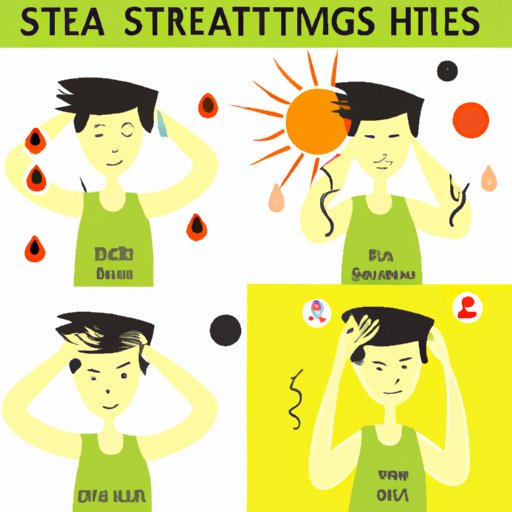
I. Introduction
Summer is a time for outdoor fun and the warmth of the sun, but it’s also the time of year when heat stress becomes a serious risk. Heat stress occurs when the body is exposed to excessive heat, which can lead to serious health problems, and even death. In this article, we’ll explore the science behind heat stress, who’s most at risk, and provide prevention tips to keep you safe all summer long.
II. The Science of Heat Stress: Causes, Symptoms, and Prevention
Heat stress occurs when the body’s ability to cool itself is overwhelmed by high temperatures and humidity, and physical exertion. Common causes of heat stress include working in hot environments, exercising in hot weather, and even being in a hot car. When the body’s temperature rises, it tries to cool itself by sweating. If sweating is not enough to reduce the body’s heat, the result can be heat stress.
Signs and symptoms of heat stress can include heat rash, cramps, exhaustion, and heat stroke. To prevent heat stress, it’s essential to stay hydrated, wear light clothing, and take breaks in cooler environments. Be sure to drink plenty of water and avoid alcohol and caffeine, which can cause dehydration.
III. Hotter Than Hot: Understanding the Risks of Heat Stress
Some people are more at risk of heat stress than others. Workers who do physical labor outdoors are among the most vulnerable, as are athletes who train or compete in hot conditions. The elderly and individuals with pre-existing medical conditions such as heart disease and high blood pressure are also at an increased risk of suffering from heat stress.
Heat stress is a serious problem because it can lead to organ failure and long-term health problems. In extreme cases, it can even lead to death if not treated properly. It’s essential to recognize the symptoms of heat stress in yourself and others, and to take action to prevent it from happening.
IV. Surviving the Heat: Tips for Workers and Athletes
If you work or exercise outdoors in the summer months, here are a few tips to help you stay safe:
- Drink plenty of water before, during, and after physical activity
- Take frequent breaks in cool, shady areas
- Wear lightweight, light-colored clothing that allows sweat to evaporate
- Use sunscreen to protect your skin from sunburn
It’s also essential to know the early warning signs of heat stress, such as excessive sweating, fatigue, and muscle cramps. If you experience any of these symptoms, stop what you’re doing and rest in a cooler location.
V. Heat Stroke vs Heat Exhaustion: Knowing the Difference Could Save Your Life
Heat exhaustion and heat stroke are two heat-related conditions with different symptoms and severity levels.
Heat exhaustion is less severe than heat stroke and can develop after exposure to high temperatures and sun. Symptoms include weakness, nausea, dizziness, headache, and fainting. It’s essential to treat heat exhaustion promptly as it can quickly progress to heat stroke if left untreated.
Heat stroke is a medical emergency that requires immediate attention. Symptoms include a high body temperature, confusion, seizures, and loss of consciousness. If someone is experiencing heat stroke, call 911 immediately and move them to a cooler location while waiting for help to arrive.
VI. Fighting Fire with Fire: How First Responders Combat Heat Stress on the Job
Firefighters and other first responders are especially vulnerable to heat stress due to the nature of their work. Protective gear and physical demands of the job make it challenging to stay cool in high temperatures. These individuals take several measures to combat heat stress, including taking frequent breaks, staying hydrated, and using cooling vests and fans to lower body temperature.
VII. The Socioeconomic Impact of Heat Stress: Why It’s a Public Health Concern
The economic and health impact of heat stress on society extends beyond just those who are directly affected. It can lead to decreased worker productivity, increased healthcare costs, and strain on public resources. With the effects of climate change becoming more pronounced, heat stress is emerging as a significant public health concern that needs immediate attention.
VIII. Staying Chill in the Heat: Natural Remedies to Beat Heat Stress
Several natural remedies can help prevent and alleviate the symptoms of heat stress, including:
- Drinking coconut water to replenish electrolytes lost through sweating
- Eating water-dense foods like watermelon and cucumber
- Taking cool showers or baths
- Using cooling towels or compresses
While these remedies are not a substitute for medical treatment, scientific evidence suggests they can be effective in reducing the risk of heat stress.
IX. Conclusion
Heat stress is a serious health consideration, particularly in the summer months when temperatures skyrocket. By staying aware of the causes and symptoms of heat stress and taking preventative measures, you can avoid potentially dangerous situations. Remember to always look out for others who may be vulnerable to heat stress, such as the elderly and individuals with pre-existing medical conditions, and to seek medical attention if symptoms of heat stroke arise.




